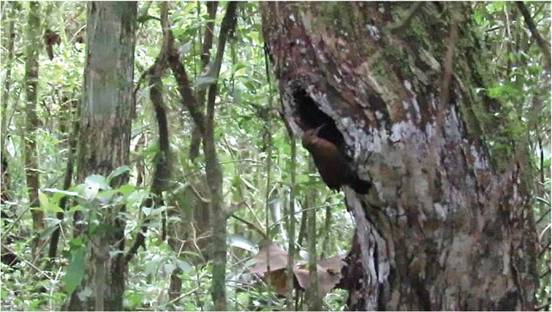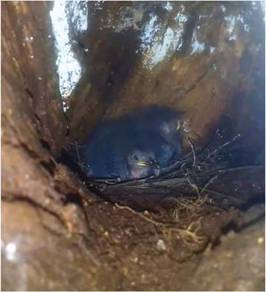Dendrocolaptinae, Furnariinae and Sclerurinae comprise the Furnariidae family, which are Subosci-ne birds that stand out for some well-defined reproductive features (Sick 1997, Derryberry et al. 2011). The Sclerurinae, as some other furnariids (Cinclodes, Automolus, and others), specialize in underground cavities to nest and usually line the incubation chamber with dry rachises (Skutch 1969, Narosky et al. 1983, Fraga and Narosky 1985, de la Peña 1987, Sick 1997, Zyskowski and Prum 1999, Remsen 2003). Differently, the Dendrocolaptinae search for tree hollows to nest, mostly found at low height from the ground (Sick 1997, Marini et al. 2002, Jesus and Mikich 2009, Lombardi et al. 2010, Derryberry et al. 2011).
The Sclerurinae is composed of grassland (ge-nus Geositta) and forest (genus Sclerurus) species, hi-ghly specialized in their respective habitats (Goerck 1997, Sick 1997, Ribon et al. 2003). Species of both genera nest in excavated cavities established in banks, a characteristic shared by some Furnariinae. In addition, Sclerurniae present other plesiomor-phic morphological and genetic characteristics that are more related to Dendrocolaptinae (Sick 1997, Ohlson et al. 2013, Guzzi et al. 2016, Machado et al. 2017). Furthermore, Sclerurus species are not known to use tree cavities in any point throughout their life history, and even roosting was observed to be in open branches or tree roots (Els and Whitney 2011, Campos-Silva 2013). Here we report for the first time on a nesting attempt of Rufous-Breasted Leaftosser (Sclerurus scansor) in a tree cavity, an unprecedented behavioral record within this family.
The nest was found in a forest remnant at the Mun. Fazenda Rio Grande, Paraná (25°39’15”S, 49°20’32”W; 918 msnm) on October 31st, 2017. This fragment is covered by Araucaria forest vegetation with an area of nearly 110 ha. The region presents few areas with exposed banks available, usually found along small streams in forested sites. Also of note are the large coverage of epiphytic plants and the occur-rence of large arboreal individuals, such as Araucaria angustifolia, Ocotea spp. and other tree species typical of advanced stages of forest succession. The landsca-pe in which the fragment is inserted is also disturbed by several anthropic impacts, due to the use of heavy machinery, vehicles, and personnel. In addition, this remnant is also frequently occupied by domestic dogs that roam freely in the area.
We found the nest with two eggs, which were not manipulated, under a substrate composed of dry pe-tioles (Fig. 1). The tree (species unidentified) in whi-ch the cavity was found presented DBH (diameter at breast height) of 97 cm, and the hole was 89 cm above the ground. Its entrance was 12 cm high and 6 cm wide, nearly oval in shape, and the cavity was 28 cm in depth, horizontally; the egg chamber was 16 cm high and 7 cm wide (Fig. 2). Cavity measurements were taken using a measuring tape after the cavity was va-cated. The nest site was located by an adult flushing from the interior of the tree cavity. This individual pre-sented clear deceptive behavior, repeatedly emitting strong calls close to the observer and exacerbating its visibility. After we found the nest, two surveys were carried out in the same year, on November 23th, and December 8th. Surveys were also executed in 2018, on March 31th, June 30th, and September 30th. Other inspections of the cavity were carried out on several occasions between 2019 and 2020. These checks were made both on and off the reproductive season to verify if there was new evidence of cavity use.
During the second survey, on November 23rd 2017, two nestlings were found, also unmanipulated (Fig. 3). Their bodies were covered with gray pin fea-thers, bright yellow commissures, and the absence of erupting flight feathers. One of the nestlings was able to open its eyes in response to stimuli in the vicinity of the cavity, also emitting short begging calls. Video recordings of parental activity captured parental care behaviors of adults delivering food to nestlings (Fig.
2) and removing fecal sacs (Fig. 4). To carry out the monitoring, a Canon PowerShot Sx60 Hs camera was used, mounted on a tripod approximately 1.30 m in height, facing the nest, about 15 m away from the cavity entrance. The observer set up the equipment and walked away, leaving it active in three sessions of 30 minutes each, at 06:18; 06:54 and 08:21. Other photographs and footage were taken in the region, but with the equipment at hand, and involving not only the nest, but adults in agonistic behavior.
On December 8th 2017 the nest was empty, but at least three individuals - presumably the parents and one of the fledglings - were seen in the area. There-fore, we assumed that this reproductive attempt was completed, resulting in at least one successfully fle-dged young. In the next survey, on March 31st 2018, new apparently predated white eggshells were found in the cavity, identified as belonging to Rufous-Breasted Leaftosser due to egg coloration and nest-covering pattern (dry petioles). This data, along with the known bird assemblage of the region, allow us to determine that only the Rufous-Breasted Leaftosser could be responsible for the nesting attempt (Sick 1997), and to suppose that a new, unsuccessful, nesting attempt was made in March. On this occasion we collected part of the nest material, and determined that its main components were leaf rachises of Mimosaceae or Fabaceae petioles. On September 30th 2018, fur-ther interventions occurred in the forest fragment with the opening of an extensive system of trails that resulted in the removal of undergrowth vegetation, including patches close to the cavity. This disorder may have affected the occupancy of the area by the species, although some individuals are still found fo-raging and vocalizing at the site.
On April 6th 2019, the cavity seemed to have been used for a new nest. However, the material found in-side did not resemble that of Rufous-Breasted Leaf-tosser as previously observed, and we presumed that another species used this hollow in that breeding season. Surveys on June 9th, August 24th, September 28th, October 26th, November 30th, and December 24th of the same year, as well as in other surveys during 2020, did not find any evidence of use of the cavity for nesting by birds.
Rufous-Breasted Leaftosser, as all other known Sclerurinae, is a bird that looks for banks with ex-posed soil to dig cavities and establish their nests at the end of excavated galleries (Sick 1997). The record of the use of a natural tree cavity, although known to some other groups within the Suboscines, is unpre-cedented for this family. However, similar cases of nesting in tree cavities have been reported in some burrow-nesting furnariids, such as some populations of Buff-winged Cinclodes (Cinclodes Juscus) and Dark--bellied Cinclodes (Cinclodes patagonicus) (Ojeda 2016, Altamirano et al. 2017). Birds are able to change their nesting sites according to a series of environmental factors, including the risk of predation and changes in microclimate conditions (Hansell 2000, Forstmeier 2001, Collias and Collias 2014). Phylloscopus Juscatus, for instance, changes the location and height of its nest according to the abundance of squirrels, its local predator (Forstmeier and Weiss 2002).
Figure 1: Nest of Rufous-Breasted Leaftosser (Sclerurus scansor) with two unmanipulated eggs found inside the tree cavity. Mun. Fazenda Rio Grande, Paraná, 31 October 2017.
Rufous-Breasted Leaftosser is a forest specialist bird (Goerck 1997), hightly sensitive to environmen-tal changes (Ribon et al. 2003), and occurs mainly in primary forests or conserved secondary forests (Aleixo 1999), with few records in altered environments (Willis and Oniki 2002). This level of specialization is usually indicative of species with less phenotypic plasticity (Pi-gliucci 2001). In addition, cavity-nesting behavior -or seeking more protected nesting sites- is also associa-ted with taxa that demonstrate less phenotypic plasti-city (Martin and Briskie 2009, Ghalambor et al. 2013).
The event reported here is evidence of a previously unknown phenotypic plasticity shown by a Sclerurinae species. Even though this record is unique, the use of a tree cavity by a single pair of Rufous-Breasted Leaftosser opens a path for some hypothetical suggestions, especially regarding the influence of local environ-mental factors on nesting behavior in this group of birds, as seen in Buff-winged Cinclodes (Ojeda 2016). The studied forest remnant is under several anthropic pressures, including its landscape context, located in a periurban region. Limited resources for nesting, such as the small availability of exposed soil banks and interspecific competition for suitable nest sites (e.g. with Canebrake Groundcreeper Clibanornis dendrocolaptoides), might also influence reproductive strategies at this locality. Finally, the area is commonly occupied by roaming domestic dogs, which also increase predation pressure on nests at low height, including ground cavities accessible to dogs. In isolation or conjunction, all these factors could influence the emergence of the peculiar behavior in Rufous-Breasted Leaftosser repor-ted herein. Thus, Rufous-Breasted Leaftosser, or even the Sclerurinae as a whole, may present higher pheno-typic plasticity than currently thought; alternatively, this event may be a reflection of a recent adaptation in populations subjected to a myriad of disturbances. We encourage research and documentation of behaviors such as this, in order to improve our collective unders-tanding of bird ecology in the Neotropics. The proper publication and discussion of isolated, unusual natural history events are inherently important to science, and can also promote further investigations of bird popula-tions. Furthermore, we cannot exclude the importance of academics, but also of citizen scientists who have a fundamental role in the construction of scientific knowledge (Silvertown 2009, Mamede et al. 2017).
Figure 2: An adult Rufous-Breasted Leaftosser (Sclerurus scansor) bringing food to nestlings and using its tail to support itself on 23rd November 2017. Mun. Fazenda Rio Grande, Paraná (25°39'15”S and 49°20,32”W, 918 m), 31st October 2017.
Figure 3: Two Rufous-Breasted Leaftosser (Sclerurus scansor) nestlings found on the second survey, on 23rd November 2017. Mun. Fazenda Rio Grande, Paraná, 31st October 2017.
Figure 4: Records of an adult removing the fecal sacs from inside the nest on 23rd November 2017. Mun. Fazenda Rio Grande, Paraná, 31st October
2017.
ACKNOWLEDGMENTS
We thank Tony Andrey Bichinski Teixeira for com-ments and suggestions on an early version of this ma-nuscript. We are also grateful for the valuable contri-butions of the editor Kristof Zyskowski and reviewers, whitch improved the quality of our manuscript.
Recibido: 13 de Agosto de 2021
Aceptado: 15 de Marzo de 2022












 uBio
uBio 





